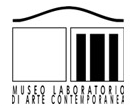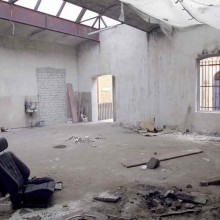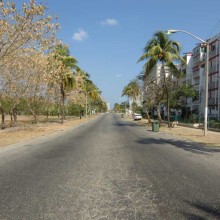Scroll down for the english version
L’arte contemporanea non è mai stata così ricca, sfarzosa, egoista e modaiola. Probabilmente in altre epoche qualcosa del genere lo si era visto, prima della Rivoluzione francese, quando il disprezzo verso la povertà era tagliente ed aggressivo, oppure durante le tirannie imperiali negli anni della decadenza di Roma. Ma l’arte ricca ed opulenta, sfarzosa e sprezzante per la comune identità dell’uomo, è una conseguenza del vuoto individualista del contemporaneo, e non si deve pensare che ciò sia ineluttabile e di conseguenza giusto. L’idea che la mondanità dell’arte sia una necessità fatalistica dei nostri giorni apre la strada ad una scorretta interpretazione del lavoro dell’artista e soprattutto del curatore, ovvero di colui che attraverso un uso spregiudicato dei suoi rapporti privilegiati dirige e seleziona. Alcune riflessioni su questi problemi mi sono sorte alla visione di un filmato presentatomi da Lella Antinozzi e Claudio Marson sul tema della gentrification. Di cosa si tratta? Il fenomeno della gentrification consiste in quel processo di riqualificazione di zone abitative depresse e depauperate attraverso la colonizzazione artistica e la successiva trasformazione sociale con l’impianto di locali alla moda, gallerie, studi e nuovi residenti. Il processo è apparentemente solo positivo. Lo abbiamo visto evolvere nelle grandi capitali internazionali da New York a Londra, da Barcellona a Milano. Cosa succede però realmente al contesto sociale in cui l’azione dell’arte viene usata come modello di imbellimento abitativo? In genere gli artisti, che sono creativi con notevoli capacità di adattamento, preferiscono stabilirsi in zone poco care e dismesse, dove la vita ha ancora un sapore etico, dove si trovano generi alimentari a poco prezzo e di buona qualità, dove i vicini per quanto strani o malavitosi hanno un generico buon senso che determina il rispetto reciproco. Di norma l’arrivo degli artisti in zone depresse delle città è visto di buon occhio dagli abitanti. Costoro, abituati ad ogni azione di malaffare, non disdegnano i nuovi arrivati e li accettano con le loro umane stranezze ed i loro costumi disincantati. D’altra parte gli artisti hanno un palese bisogno di accettazione sociale, in particolare nei momenti in cui non hanno particolari riconoscimenti e trovano nelle popolazioni di questi quartieri un coefficiente d’umanità accettabile, per quanto difficile e complicato. Il fenomeno che ha riqualificato zone depresse di New York, come il Greenwich Village, Tribeca e l’East Village, e che a Londra ha portato alla completa trasformazione di intere zone, come Camden o Nottingham Hill Gate, ha assunto nella città di Berlino caratteristiche molto più imponenti. Il fatto è che su sostegno del senato cittadino Berlino ha vissuto il fenomeno della gentrification in maniera pianificata e totalizzante. Alla caduta del muro Berlino era una città in cui interi quartieri dell’Est, posizionati in quello che è di fatto il suo centro, risultavano completamente dismessi, vuoti e abbandonati. Molti artisti in quegli anni trovarono più economico spostarsi in quella zona della città dove si potevano affittare enormi locali privi dei comfort occidentali ma a bassissimo prezzo. L’emigrazione artistica che ha avuto nel quartiere di Mitte il suo epicentro ha prodotto una nuova connotazione sociale, ha riempito gli spazi dismessi e ha riqualificato culturalmente la zona. Ma successivamente, dopo la nascita delle grandi istituzioni volute dagli artisti, come il KW divenuto sede principale della Biennale di Berlino, il prezzo degli affitti è lievitato. Al posto dei pionieri, artisti e letterati, sono arrivati i primi galleristi, e con questi i locali alla moda pensati per un pubblico culturalmente impegnato e con buona disponibilità di denaro. Gli edifici sono stati restaurati, e alla fine il quartiere ha di fatto perso la sua originaria identità favorendo i grandi investitori immobiliari. In fondo, si dice allora, gli artisti e la loro presenza, sono il veicolo principale di una speculazione che ha di fatto svilito il contesto sociale e ha favorito i grossi capitali. D’altra parte proprio a Berlino agiscono diversi grandi proprietari che hanno eletto il sistema della gentrification a modello di riqualificazione urbana. Questo, come si capisce, non ha nulla di artistico. Il problema della gentrification non è uno strumento esclusivo nelle mani di alcuni spregiudicati investitori ma può diventare una scelta di Stato. In qualche modo l’esempio di Berlino ce lo dice chiaramente. I nuovi piani di sviluppo raccontati dal documento ci parlano di una scelta politica sempre più radicalmente proiettata alla riqualificazione della città in funzione culturale, ma che, in ultima analisi, prevede il radicamento di una classe sociale di fatto estranea al contesto e l’espulsione dei residenti poveri. Qualcosa di molto simile sta succedendo nel centro storico dell’Havana, una città densa di storia popolare e di quartieri vitali. Il vecchio centro della città, Havana Vieja, quello più ricco di storia e di memoria e densamente abitato, è stato riconosciuto da qualche anno patrimonio del’Unesco. Il fatto ha naturalmente indirizzato verso quella zona della città, antica e desolata, una forte affluenza di capitali esteri, con il conseguente restauro di un nucleo principale di edifici storici. Diversamente da quanto è successo nelle altre capitali, e per via di un dirigismo centralizzato, nella città dell’Havana la gentrification nasce dall’impianto di numerosi locali culturali imposti dal governo, ma il risultato, nella nuova cosmesi dell’impianto cittadino è che la popolazione viene allontanata con metodi brutali e immediati. Rimane un perfetto luna-park turistico estraneo alla cultura del luogo, lindo e contraddittorio rispetto alle reali condizioni di vita delle masse cubane. Un bubbone di zucchero nato e cresciuto per via di concessioni artistiche e sede peraltro della Biennale cubana. Oggi l’arte contemporanea è opulenta come non mai. Ma la sua opulenza nasce dai finanziamenti e dagli appetiti di un capitalismo incurante della storia e della memoria, indifferente all’arte e agli artisti. L’immagine di questa opulenza certifica il desiderio di potere illusorio degli artisti ma in realtà favorisce un sistema speculativo che si esprime in vario modo, partendo dalla volontà di usare il fenomeno artistico per incrementare i profitti da cui, a parte una piccola minoranza, gli artisti ed i critici sono esclusi. L’opulenza è quindi la faccia smagliante di un’arte in mano ad un potere politico che la usa in modo improprio per scopi di diplomazia nazionale, come nel caso delle biennali proliferate ovunque, e di un sistema di capitali che compie investimenti complessi attraverso la strumentalizzazione di ignare frange creative. Ci si chiederà allora in cosa consista l’interesse di un simile intervento, nella consapevolezza oramai diffusa di una inequivocabile coesistenza di arte e grandi capitali, ciò che per l’appunto giustifica l’opulenza dell’arte. Oggi mi chiedo a cosa si deve questa evidente mancanza di disagio da parte dell’arte. Trovo alquanto deprimente che gli artisti e i critici non si rispecchino nelle scelte compiute, ma che anzi galleggino su questo mare speculativo nella convinzione di essere in grado di reggere il campo e di guidarlo. Ci si aspetterebbe quanto meno un atteggiamento analitico, la convinzione consapevole di essere strumenti nelle mani astute di chi i capitali li gestisce e li usa per un suo profitto. Questo svelamento è ciò che l’arte ha fatto nelle sue fasi più radicali ma anche nelle sue fasi di complicità con il capitale. Flirtare con questo non significa infatti fingere di esserne i gestori esclusivi. L’idea che l’artista si possa salvare attraverso la consapevolezza del suo ruolo è caduta in disuso, l’intelligenza è stata soppiantata dalla complicità ignara, l’acutezza si è trasformata in omertà. Adesso l’arroganza imbecille dell’arte passa attraverso la fiction di una sua reale coabitazione col potere, quando invece agisce in una zona franca che le consente d’esistere ma solo per la sua innocuità. In un recinto foraggiato come le vacche grasse nelle fabbriche del latte. E l’arte opulenta di questi anni, che ha invaso con i suoi curatori e si suoi artisti sprezzanti del mondo reale e carichi di privilegi, con i suoi modelli viziati da un mercato che si autopromuove grazie ai capitali, non palesa alcun dubbio e non evidenzia alcuna perplessità sul suo ruolo e sulla sua identità. Come se una deflagrazione d’astinenza intellettiva avesse irrorato con le sue malefiche esalazioni radioattive il territorio dell’arte e ne avesse fatto un terreno sperimentale del profitto. Ci si potrebbe aspettare un minimo di umanità da questi artisti favoriti dalla luna e dal suo destino, ma ciò che sgomenta è che nella miseria della loro condizione di schiavi nelle mani speculative essi professano gioiosamente la fede nel profitto che generano e di cui raccolgono le briciole, come se ne fossero artefici e non vittime. Ciò che sconvolge l’intelligenza, in questo calderone d’opulenza in un mondo pervaso dai brividi della sopravvivenza e dalla fame, è il disprezzo ricco di spocchia che l’arte ufficiale ha saputo spandere nel contesto della cultura dimenticando ciò che si è e ciò che si fa, dimenticando il disagio d’essere i migliori alleati dei propri nemici.
Giugno 2009.
English version
Contemporary art has never before been quite so rich, glitzy, egotistic and fashionable. Something similar has probably been seen in other times, before the French Revolution, when disdain for poverty was sharp and aggressive, or during the imperial tyranny in the years of Roman decadence. This art which is rich and opulent, sumptuous and contemptuous of mans common identity, is a consequence of the individualistic face of the contemporary, but it should not be thought to be inescapable and therefore right. The idea that the worldly nature of art is a fatalistic necessity of our time opens the way for an incorrect interpretation of the work of artist and above all the curator, or rather of he who by means of a shameless use of his privileged relations directs and selects. I came to reflect upon these problems whilst watching a film presented to me by Lella Antinozzi and Claudio Marson on the theme of gentrification. What is it about? The phenomenon of gentrification consists of the process of redeveloping depressed and deprived urban areas by means of an artistic colonization and the successive social transformation with the setting up of trendy bars, clubs, galleries, studios and new residents. The process appears to be only positive. We have seen it take place in the great international capitals from New York to London, from Barcelona to Milan. But what is it that really happens in a social context in which artistic activity becomes a model for housing beautification? In general artists, who are creative and notably adaptable, prefer to set themselves up in areas that are less expensive and rundown, where life still has an ethical feel, where food can be found at a low cost but of high quality, where neighbours however strange and unsavoury have a general good sense of mutual respect. In general the arrival of artists in a rundown urban area is welcomed by the local inhabitants. These people, used to affairs of questionable legality, have no disdain for the new arrivals and they accept them with their human peculiarities and their world-weary clothes. On the other side artists have an evident need for social acceptance, in particular in moments of little recognition and they find an acceptable humanity in the inhabitants of these areas, in spite of the difficulties and complications. The phenomenon, that has redeveloped rundown zones of New York, such as Greenwich Village, Tribeca and the East Village, and which in London has lead to the transformation of entire areas, like Camden Town or Notting Hill Gate, has assumed in the city of Berlin far more imposing characteristics. The fact is that with the backing of the citizen senate gentrification in Berlin has been planned and is all engaging. When the wall was torn down Berlin was a city in which entire areas of the east, positioned in what is in fact the city centre, were rundown, empty and abandoned. Many artists in those years found it more economical to move into those areas of the city where they could rent huge premises, without western comforts, but at an extremely low cost. The artistic emigration that centred itself in the Mitte district produced a new social connotation; it filled the rundown areas and culturally redeveloped the zone. But subsequently, after the formation of institutions that the artists had sought, such as the KW that became the principle centre of the Berlin Biennale, the rental costs rose. In place of the pioneers, artists and literati, the first gallerists arrived, and with this the trendy venues conceived for a culturally engaged public with a disposable income. The buildings were restored, and in the end the area lost its original identity favouring large property investors. We can therefore say that the artists and their presence are the principle vehicles of large economic speculation that debased the original social context. On the other hand in Berlin there are many large property developers at work that have chosen the system of gentrification as the model for urban redevelopment. This, it is clear, is in no way artistic. The gentrification problem is not a device exclusively in the hands of reckless, shameless investors but it can also become the State choice. In some ways the example of Berlin shows us this clearly. The new development plans reported in this documentary speak of a political choice ever more radically projected towards the cultural redevelopment of the city, but which, in the latest analysis, predicts the laying of roots by a social class that has nothing to do with the context and the eviction of poor residents. Something very similar is also happening in the historic centre of Havana, a city full of popular history and vibrant areas. The old centre of the city, Havana Vieja, the area richest in history, memories and most densely populated, has been awarded world heritage status by UNESCO. This has naturally led to a large flow of foreign investment towards this ancient and desolate part of the city, with the subsequent restoration of this area of mainly historical buildings. Unlike what has happened in other capitals, as a result of central planning, gentrification has resulted from the establishment of numerous cultural premises by the government, but the result of the areas facelift is that the local population has been moved away by use of brutal and instantaneous methods. What is left is a perfect tourist fairground unrelated to the local culture, neat and inconsistent with the real living conditions of the Cuban masses. A sugary bubble born and grown out of these artistic concessions that also includes the centre of the Cuban Biennale. Today contemporary art is opulent like never before. But its opulence is born of the finances and appetite of a capitalism with no care for history or memory and a lack interest in art and artists. The opulent image demonstrates the artists illusory desire for power but in reality it favours a system of economic speculation that expresses itself in a number of ways, starting with the wish to use the artistic phenomenon to increase profits form which, apart from a small minority, the artists and critics are excluded. The opulence is therefore the glittery face of an art in the hands of a political power that uses it improperly for the purpose of national diplomacy, for instance the biennales proliferating everywhere, and of a system where capital is used to carry out complex investments through the exploitation of unaware creative fringes. It must therefore be asked what the interest is behind such an intervention, in the now widespread knowledge of an undeniable coexistence between art and large capital, which justifies the opulence of art. Today I wonder what the reason is for this arts evident lack of discomfort. I find it somewhat depressing that artists and critics do no reflect upon their choices, but instead float upon this speculative sea convinced that they are able keep control of the field and run it. One would expect at least an analytical attitude, the conscious knowledge of being tools in the astute hands of who runs these funds and uses them for their own profit. This uncovering is that which art has done in its most radical phases, but also in its phases of economic complicity. Flirting with this does not in fact mean pretending to have exclusive control. The idea that the artist can save himself through the knowledge of his role has been abandoned, intelligence has been displaced by an unknowing complicity, and acuteness has been transformed into denial. Now the foolish arrogance of art passes through the fiction of a real ability to coexist with power, when in reality it operates in a no man’s land and is allowed to exist only as a result of its harmlessness. Penned in like fat cows in a milk factory. And the opulent art of recent years, which has invaded with its privileged curators and artists full of for contempt for the real world, with its models spoilt by a market that promotes itself thanks to this capital, does not display any doubt or show any perplexity towards its role or identity. As though an explosion of intellectual abstinence has showered the artistic field with its noxious radioactive fumes and created a field of experimental profit making. A bit of humanity could be expected from these artists whose destiny was written in the stars, but what is shocking is that in the misery of their condition as slaves in speculative hands they joyfully profess faith in the profits they make and of which they collect only the crumbs, as though they were the masterminds and not the victims. That which is troubling and illogical, given the world filled with hunger and the struggle for survival that surrounds this cauldron of opulence, is the conceited arrogance that this art of the system has spread into other cultural areas forgetting what it is and what it does, overlooking the discomfort of being the best ally of your worst enemy.
Fig. 1
Pavel Althamer, installazione alla Berlin Biennial, Berlino, 2006. Courtesy Berlin Biennial, KW.
Fig. 2
Kcho, con i suoi assistenti, lavora all’installazione nella Plaza Vieja, Havana Vieja, Biennale dell’Havana 2006, osservato dalla curatrice Lucrezia Cippitelli e dall’occhio fotografico di Daniele Statera. Foto Domenico Scudero.
Fig. 3
La strada principale di Alamar, estrema periferia ad est di Havana, priva di servizi e collegamenti, dove sono stati deportati i vecchi residenti di Havana Vieja. Foto Domenico Scudero.
Fig. 4
Una installazione nello Skulpturenpark di Berlino, zona destinata a diventare un parco d’arte, in occasione della 5th Berlin Biennial, 2008. Foto Domenico Scudero.






